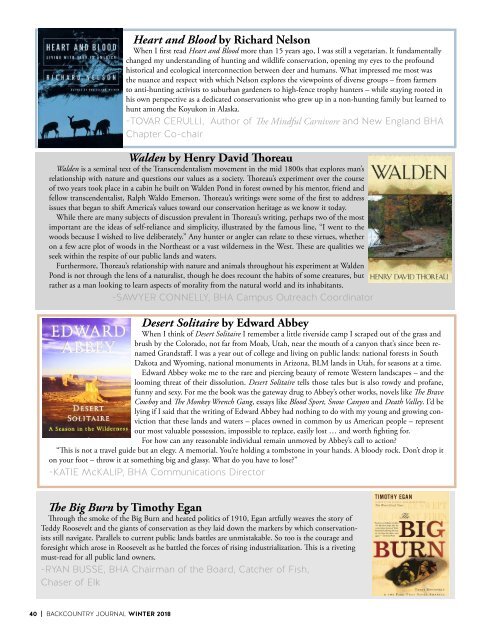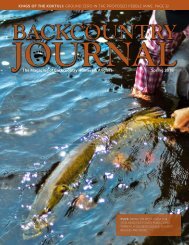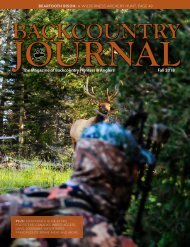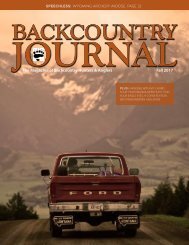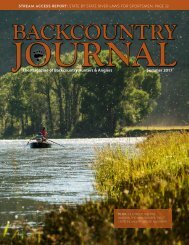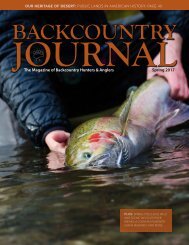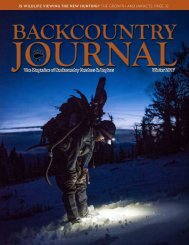BCJ_WINTER18 Digital Edition
You also want an ePaper? Increase the reach of your titles
YUMPU automatically turns print PDFs into web optimized ePapers that Google loves.
Heart and Blood by Richard Nelson<br />
When I first read Heart and Blood more than 15 years ago, I was still a vegetarian. It fundamentally<br />
changed my understanding of hunting and wildlife conservation, opening my eyes to the profound<br />
historical and ecological interconnection between deer and humans. What impressed me most was<br />
the nuance and respect with which Nelson explores the viewpoints of diverse groups – from farmers<br />
to anti-hunting activists to suburban gardeners to high-fence trophy hunters – while staying rooted in<br />
his own perspective as a dedicated conservationist who grew up in a non-hunting family but learned to<br />
hunt among the Koyukon in Alaska.<br />
-TOVAR CERULLI, Author of The Mindful Carnivore and New England BHA<br />
Chapter Co-chair<br />
Walden by Henry David Thoreau<br />
Walden is a seminal text of the Transcendentalism movement in the mid 1800s that explores man’s<br />
relationship with nature and questions our values as a society. Thoreau’s experiment over the course<br />
of two years took place in a cabin he built on Walden Pond in forest owned by his mentor, friend and<br />
fellow transcendentalist, Ralph Waldo Emerson. Thoreau’s writings were some of the first to address<br />
issues that began to shift America’s values toward our conservation heritage as we know it today.<br />
While there are many subjects of discussion prevalent in Thoreau’s writing, perhaps two of the most<br />
important are the ideas of self-reliance and simplicity, illustrated by the famous line, “I went to the<br />
woods because I wished to live deliberately.” Any hunter or angler can relate to these virtues, whether<br />
on a few acre plot of woods in the Northeast or a vast wilderness in the West. These are qualities we<br />
seek within the respite of our public lands and waters.<br />
Furthermore, Thoreau’s relationship with nature and animals throughout his experiment at Walden<br />
Pond is not through the lens of a naturalist, though he does recount the habits of some creatures, but<br />
rather as a man looking to learn aspects of morality from the natural world and its inhabitants.<br />
-SAWYER CONNELLY, BHA Campus Outreach Coordinator<br />
Desert Solitaire by Edward Abbey<br />
When I think of Desert Solitaire I remember a little riverside camp I scraped out of the grass and<br />
brush by the Colorado, not far from Moab, Utah, near the mouth of a canyon that’s since been renamed<br />
Grandstaff. I was a year out of college and living on public lands: national forests in South<br />
Dakota and Wyoming, national monuments in Arizona, BLM lands in Utah, for seasons at a time.<br />
Edward Abbey woke me to the rare and piercing beauty of remote Western landscapes – and the<br />
looming threat of their dissolution. Desert Solitaire tells those tales but is also rowdy and profane,<br />
funny and sexy. For me the book was the gateway drug to Abbey’s other works, novels like The Brave<br />
Cowboy and The Monkey Wrench Gang, essays like Blood Sport, Snow Canyon and Death Valley. I’d be<br />
lying if I said that the writing of Edward Abbey had nothing to do with my young and growing conviction<br />
that these lands and waters – places owned in common by us American people – represent<br />
our most valuable possession, impossible to replace, easily lost … and worth fighting for.<br />
For how can any reasonable individual remain unmoved by Abbey’s call to action?<br />
“This is not a travel guide but an elegy. A memorial. You’re holding a tombstone in your hands. A bloody rock. Don’t drop it<br />
on your foot – throw it at something big and glassy. What do you have to lose?”<br />
-KATIE McKALIP, BHA Communications Director<br />
The Big Burn by Timothy Egan<br />
Through the smoke of the Big Burn and heated politics of 1910, Egan artfully weaves the story of<br />
Teddy Roosevelt and the giants of conservation as they laid down the markers by which conservationists<br />
still navigate. Parallels to current public lands battles are unmistakable. So too is the courage and<br />
foresight which arose in Roosevelt as he battled the forces of rising industrialization. This is a riveting<br />
must-read for all public land owners.<br />
-RYAN BUSSE, BHA Chairman of the Board, Catcher of Fish,<br />
Chaser of Elk<br />
40 | BACKCOUNTRY JOURNAL WINTER 2018


